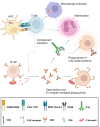Q fever immunology: the quest for a safe and effective vaccine
- PMID: 37679410
- PMCID: PMC10484952
- DOI: 10.1038/s41541-023-00727-6
Q fever immunology: the quest for a safe and effective vaccine
Abstract
Q fever is an infectious zoonotic disease, caused by the Gram-negative bacterium Coxiella burnetii. Transmission occurs from livestock to humans through inhalation of a survival form of the bacterium, the Small Cell Variant, often via handling of animal parturition products. Q fever manifests as an acute self-limiting febrile illness or as a chronic disease with complications such as vasculitis and endocarditis. The current preventative human Q fever vaccine Q-VAX poses limitations on its worldwide implementation due to reactogenic responses in pre-sensitized individuals. Many strategies have been undertaken to develop a universal Q fever vaccine but with little success to date. The mechanisms of the underlying reactogenic responses remain only partially understood and are important factors in the development of a safe Q fever vaccine. This review provides an overview of previous and current experimental vaccines developed for use against Q fever and proposes approaches to develop a vaccine that establishes immunological memory while eliminating harmful reactogenic responses.
© 2023. Springer Nature Limited.
Conflict of interest statement
The authors declare no competing interests.
Figures



References
-
- Derrick, E. “Q” fever, a new fever entity: clinical features, diagnosis and laboratory investigation. Med. J. Aust. 2, 281–299 (1937). - PubMed
-
- Cox, H. R. & Beli, E. J. The cultivation of Rickettsia diaporica in tissue culture and in the tissues of developing chick embryos. Public Health Rep.54, 2171–2178 (1939).
-
- Cutler, S. J. Bacteria: Coxiella burnetii. In Encyclopedia of Food Safety (ed. Motarjemi, Y.) 410–416 (Academic Press, 2014).
Publication types
LinkOut - more resources
Full Text Sources

